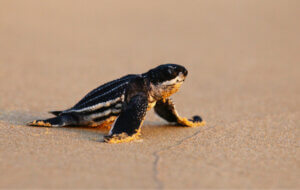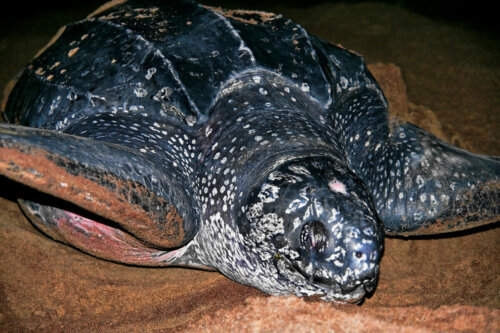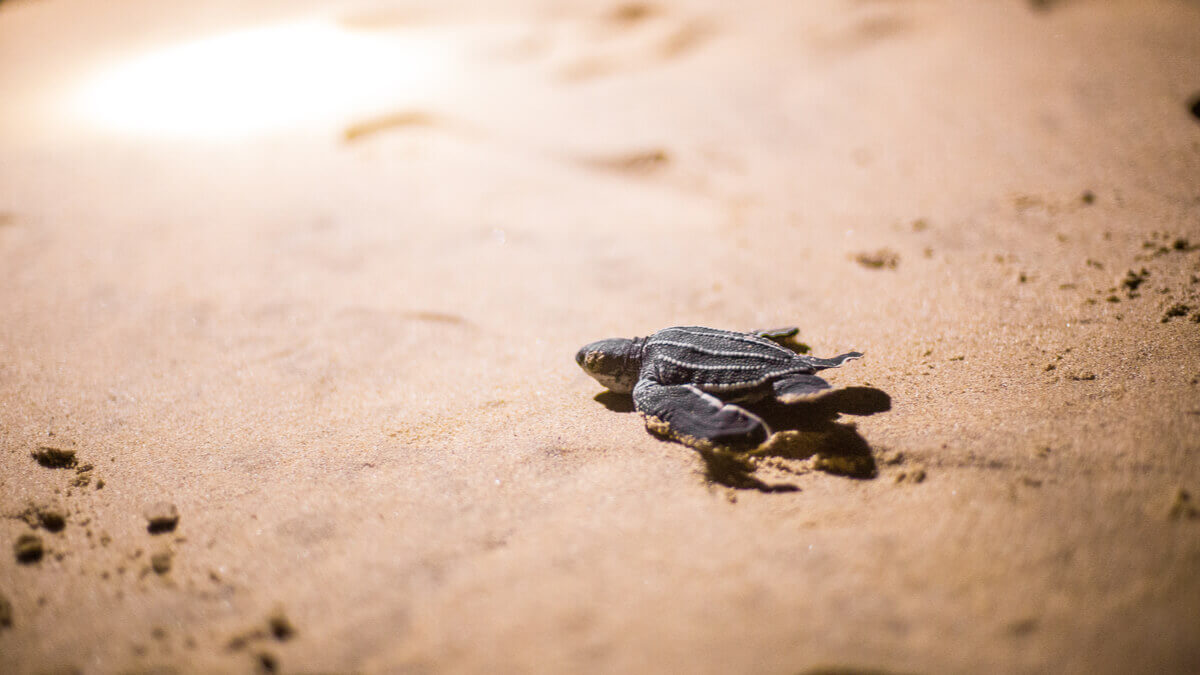Leatherback Sea Turtle Hatchlings: Why Do They Become Disoriented?

Leatherback sea turtle hatchlings spawning on the beach, followed by small hatchlings crawling to the sea, are beautiful sights to see. However, hatchlings sometimes divert from this course. Find out why leatherback sea turtle hatchlings become disoriented in this article.
In the following article, you’ll learn a little more about this species, as well as the answer to this question. If you keep reading, we’re sure you’ll fall in love with this amazing turtle species.
Biology of the leatherback sea turtle
Before going into details, we’re going to tell you more about this species. The leatherback sea turtle (Dermochelys coriacea), of the Dermochelyidae family, is the biggest of all sea turtles. It can measure up to 7.5 feet and weigh up to 1323 pounds.
According to the International Union for Conservation of Nature (IUCN), this is a vulnerable species and its population is in decline. Its found in almost all the oceans of the world. In fact, this animal undertakes transoceanic migrations to seek the warmer waters of the equator during the winter and cooler waters during the summer.
These turtles have been mostly sighted in cold water that other species don’t inhabit. This is because their large size allows them to better regulate their body temperature compared to other ectothermic species.
The leatherback sea turtle’s diet mostly consists of jellyfish and seaweed. Due to the translucent nature of jellyfish, many sea turtles swallow bags and other plastics. This is because they mistake them for their prey.

The reproduction of the leatherback sea turtle
To understand why leatherback sea turtle hatchlings become disoriented, it’s important for you to know how they reproduce. After mating in the sea, the female travels to the beach where it was born to nest and spawn. This happens every two to four years.
The female digs a hole in the beach and lays her eggs in it at night. Then, she buries them in the sand. The eggs incubate for 60 days. When the eggs hatch, the leatherback sea turtle hatchlings will dig their way to the surface and will emerge at dusk to begin their journey to the sea.
During this short journey, the leatherback sea turtle hatchlings will have to get around various predators, such as other reptiles, crustaceans, or birds. Once they reach the water after having avoided many other threats, these reptiles will never return to shore, except when the females grow and mate.
This moment is crucial to understanding why leatherback sea turtles hatchlings become disoriented, as this is when they sometimes lose their way.
Why leatherback sea turtle hatchlings become disoriented
How do the hatchlings know they have to crawl to the sea? We mentioned above that they’re born at dusk, meaning they have poor visibility. In addition, this path is full of predators.
The answer to this question is that they’re oriented by the moon. The brightness of the moon guides them towards the sea as if it were a lighthouse. Now that you know this, you can finally find out why leatherback sea turtle hatchlings become disoriented on their way to the ocean.
1. City lights
Construction for tourism and the expansion of cities is a threat to all species, specifically to the leatherback sea turtle, due to light pollution. The proximity of city lights confuses baby turtles and makes them go towards the city instead of heading to the sea.
Instead of reducing their light pollution levels, some populated centers have chosen to place spotlights on the beach so that the hatchlings follow them in the right direction. This way, they prevent the city lights from disorienting them.
2. Roads and vehicles
When the hatchlings become disoriented and head towards the city lights, they’re often run over while crossing roads and paths. Some cities have installed underpasses in the hope of being able to rescue them alive and take them to the sea.
3. Tourism
Seeing these little hatchlings crawl to the ocean or their gigantic mother spawn are unique experiences. However, big crowds can stress the mother out, making laying very difficult.
Leatherback sea turtles could also become disoriented because they mistake all those tourists for predators, so they change course to get away from them.
Other dangers for leatherback sea turtles
As a conclusion, we decided to emphasize the importance of respecting nature and other living things. Indiscriminate hunting, illegal fishing, and even global warming endanger the survival of this species.
When the Gulf Stream warms up due to climate change, leatherback sea turtles become disoriented and swim towards colder waters.

Despite conservationists’ great efforts to keep this species safe, hatchlings have to overcome many obstacles before they reach the sea. Everyone has to do their part to ensure that we can continue enjoying the wonders that this planet and its living beings offer us.
Leatherback sea turtle hatchlings spawning on the beach, followed by small hatchlings crawling to the sea, are beautiful sights to see. However, hatchlings sometimes divert from this course. Find out why leatherback sea turtle hatchlings become disoriented in this article.
In the following article, you’ll learn a little more about this species, as well as the answer to this question. If you keep reading, we’re sure you’ll fall in love with this amazing turtle species.
Biology of the leatherback sea turtle
Before going into details, we’re going to tell you more about this species. The leatherback sea turtle (Dermochelys coriacea), of the Dermochelyidae family, is the biggest of all sea turtles. It can measure up to 7.5 feet and weigh up to 1323 pounds.
According to the International Union for Conservation of Nature (IUCN), this is a vulnerable species and its population is in decline. Its found in almost all the oceans of the world. In fact, this animal undertakes transoceanic migrations to seek the warmer waters of the equator during the winter and cooler waters during the summer.
These turtles have been mostly sighted in cold water that other species don’t inhabit. This is because their large size allows them to better regulate their body temperature compared to other ectothermic species.
The leatherback sea turtle’s diet mostly consists of jellyfish and seaweed. Due to the translucent nature of jellyfish, many sea turtles swallow bags and other plastics. This is because they mistake them for their prey.

The reproduction of the leatherback sea turtle
To understand why leatherback sea turtle hatchlings become disoriented, it’s important for you to know how they reproduce. After mating in the sea, the female travels to the beach where it was born to nest and spawn. This happens every two to four years.
The female digs a hole in the beach and lays her eggs in it at night. Then, she buries them in the sand. The eggs incubate for 60 days. When the eggs hatch, the leatherback sea turtle hatchlings will dig their way to the surface and will emerge at dusk to begin their journey to the sea.
During this short journey, the leatherback sea turtle hatchlings will have to get around various predators, such as other reptiles, crustaceans, or birds. Once they reach the water after having avoided many other threats, these reptiles will never return to shore, except when the females grow and mate.
This moment is crucial to understanding why leatherback sea turtles hatchlings become disoriented, as this is when they sometimes lose their way.
Why leatherback sea turtle hatchlings become disoriented
How do the hatchlings know they have to crawl to the sea? We mentioned above that they’re born at dusk, meaning they have poor visibility. In addition, this path is full of predators.
The answer to this question is that they’re oriented by the moon. The brightness of the moon guides them towards the sea as if it were a lighthouse. Now that you know this, you can finally find out why leatherback sea turtle hatchlings become disoriented on their way to the ocean.
1. City lights
Construction for tourism and the expansion of cities is a threat to all species, specifically to the leatherback sea turtle, due to light pollution. The proximity of city lights confuses baby turtles and makes them go towards the city instead of heading to the sea.
Instead of reducing their light pollution levels, some populated centers have chosen to place spotlights on the beach so that the hatchlings follow them in the right direction. This way, they prevent the city lights from disorienting them.
2. Roads and vehicles
When the hatchlings become disoriented and head towards the city lights, they’re often run over while crossing roads and paths. Some cities have installed underpasses in the hope of being able to rescue them alive and take them to the sea.
3. Tourism
Seeing these little hatchlings crawl to the ocean or their gigantic mother spawn are unique experiences. However, big crowds can stress the mother out, making laying very difficult.
Leatherback sea turtles could also become disoriented because they mistake all those tourists for predators, so they change course to get away from them.
Other dangers for leatherback sea turtles
As a conclusion, we decided to emphasize the importance of respecting nature and other living things. Indiscriminate hunting, illegal fishing, and even global warming endanger the survival of this species.
When the Gulf Stream warms up due to climate change, leatherback sea turtles become disoriented and swim towards colder waters.

Despite conservationists’ great efforts to keep this species safe, hatchlings have to overcome many obstacles before they reach the sea. Everyone has to do their part to ensure that we can continue enjoying the wonders that this planet and its living beings offer us.
All cited sources were thoroughly reviewed by our team to ensure their quality, reliability, currency, and validity. The bibliography of this article was considered reliable and of academic or scientific accuracy.
Caut, S., Guirlet, E., Jouquet, P., Girondot, M. (2006). Influence of nest location and yolkless eggs on the hatching success of leatherback turtle clutches in French Guiana. Can. J. Zool., 84: 908-915.
Wallace, B.P., Tiwari, M. & Girondot, M. 2013. Dermochelys coriacea. The IUCN Red List of Threatened Species 2013: e.T6494A43526147. https://dx.doi.org/10.2305/IUCN.UK.2013-2.RLTS.T6494A43526147.en.
Tortuga laúd – Dermochelys coriacea – Reproducción. (2009). Enciclopedia virtual de los vertebrados españoles (CSIC). http://www.vertebradosibericos.org/reptiles/reproduccion/dercorre.html
This text is provided for informational purposes only and does not replace consultation with a professional. If in doubt, consult your specialist.








